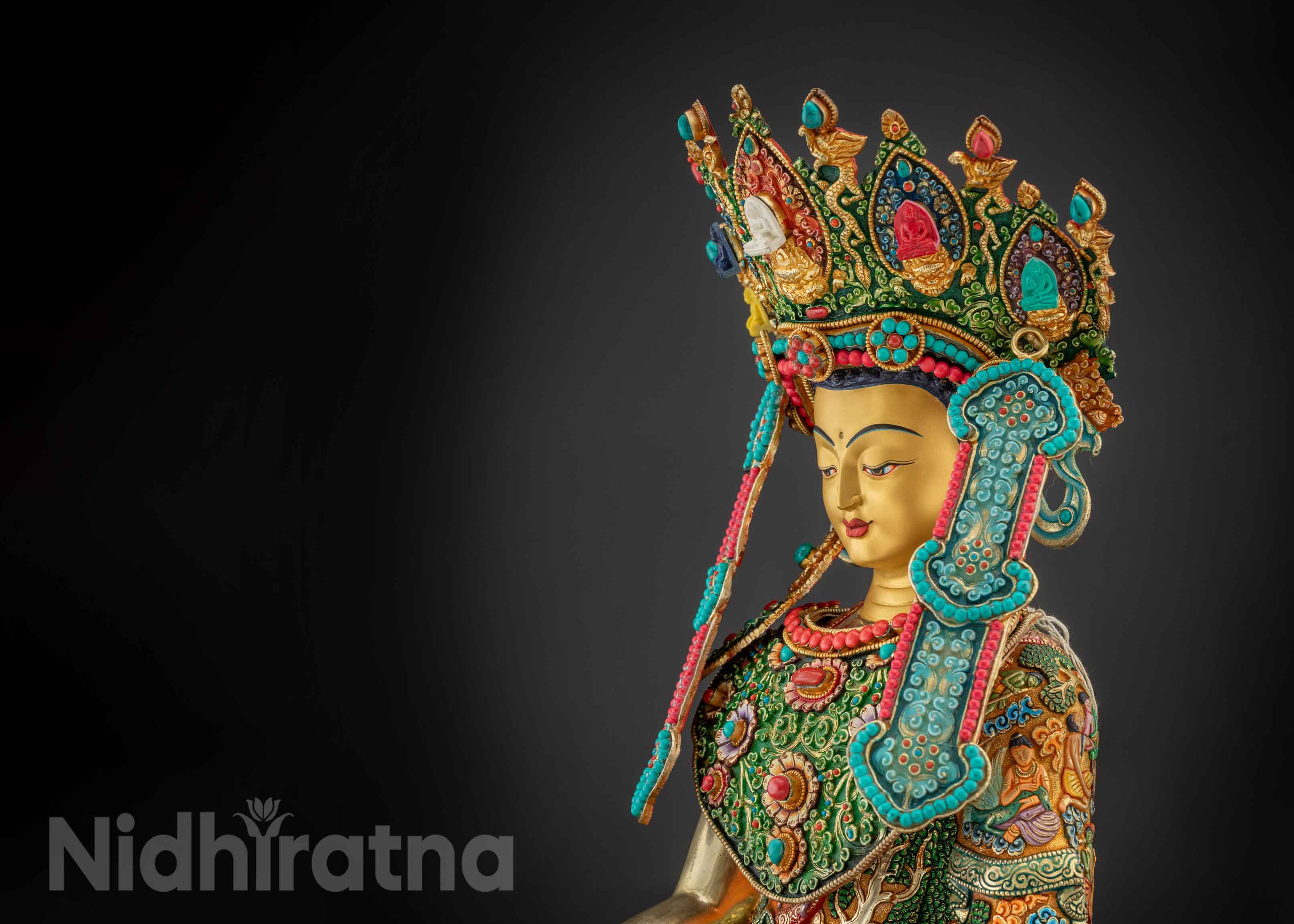Jowo Rinpoche Buddha: The Sacred Heart of Tibetan Buddhism in Lhasa
In the heart of Lhasa, Tibet, resides the most sacred and worshipped Buddha statue in the world-Jowo Rinpoche Buddha, also known as Jowo Shakyamuni. Enshrined in the Shakyamuni Buddha Hall of Jokhang Temple, this statue represents the living essence of Tibetan Buddhist faith, devotion, and artistry. People respectfully call it Jowo Rinpoche, where “Jowo” means “supreme” and “Rinpoche” means precious treasure", reflecting its revered status as Tibet's supreme sacred Buddha treasure.
A Sacred Legend Rooted in the Life of the Buddha
The Jowo Rinpoche statue was crafted during the lifetime of Siddhartha Gautama, the historical Buddha, and depicts him at the age of twelve. This youthful portrayal symbolizes enlightenment, purity, and compassion. According to Tibetan tradition, the Buddha himself blessed the statue, making it a living embodiment of the Buddha.
For centuries, devotees have regarded Jowo Rinpoche as not just a statue, but as the Buddha’s presence in Tibet, capable of offering blessings, purifying karma, and inspiring spiritual growth.
From India and Nepal to Tibet: The Sacred Journey of Jowo Rinpoche
The statue was brought to Tibet in the 7th century by Princess Wencheng of China and Princess Bhrikuti of Nepal, both married to King Songtsen Gampo. To house the sacred image, the king built the Jokhang Temple in Lhasa, which became the central hub of Tibetan Buddhism and pilgrimage.
Today, Jokhang Temple and Jowo Rinpoche Buddha continue to attract thousands of pilgrims, who travel long distances to receive blessings and perform devotional practices such as the sacred kora (circumambulation) and offering khatas and butter lamps.
Jowo Rinpoche: Symbolism, Artistry, and Spiritual Significance
The Jowo Rinpoche statue in Lhasa depicts the Buddha seated in the lotus position (Padmasana), with the left hand in the Dhyana Mudra (gesture of meditation) and the right hand in the Bhumisparsha Mudra (earth-touching gesture), representing the moment of enlightenment under the Bodhi tree.
The Significance of Postures and Mudras
-
Dhyana Mudra: Promotes inner peace, concentration, and meditation.
-
Bhumisparsha Mudra: Symbolizes the Buddha calling the earth as a witness to his enlightenment.
-
Padmasana (Lotus Position): Represents stability, purity, and spiritual awakening.
Ornaments, Jewels, and Symbolism

Jowo Rinpoche is adorned with silk robes, a golden crown, and shimmering jewels, each symbolizing devotion, enlightenment, and the union of spiritual and artistic mastery. The lotus throne represents purity arising from worldly suffering (samsara), while the golden hue embodies the radiant perfection of enlightenment.
Artisans and Preservation of the Sacred Image
For centuries, Tibetan and Nepalese artisans have contributed to adorning and preserving Jowo Rinpoche. The statue stands as a rare art treasure, blending sacred craftsmanship with devotional meaning, exemplifying the Himalayan Buddhist art tradition.
The Living Heart of Tibetan Devotion
The Jowo Rinpoche Buddha is a living symbol of Tibetan faith, inspiring generations of pilgrims and monks. Devotees perform full-body prostrations, kora, and ritual offerings at Jokhang Temple, believing that even a brief encounter with the statue brings immense spiritual blessings.
Pilgrimage Rituals and Festivals
During the Great Prayer Festival (Monlam Chenmo), thousands gather in front of Jowo Rinpoche to chant prayers, light butter lamps, and honor the Buddha. The festival emphasizes collective devotion, unity, and the enduring spiritual heritage of Tibetan Buddhism.
A Symbol of Tibet’s Cultural and Spiritual Identity
Jowo Rinpoche is not just a religious icon; it is a cultural treasure that unites faith, art, and history. The statue has survived political changes, invasions, and natural challenges, standing as a testament to the resilience and devotion of the Tibetan people.
Impact on Himalayan Buddhist Art
The sacred image has inspired countless Nepalese and Tibetan artisans to create Buddha statues, thangkas, and ritual objects, maintaining the authentic style and symbolism of Jowo Rinpoche. Its influence is seen in Buddhist art across Himalayan regions, including Nepal, Bhutan, and northern India.
Preservation and Pilgrimage
Despite the passage of more than thirteen centuries, the Jowo Rinpoche remains remarkably well-preserved. Its survival through countless historical challenges is seen by devotees as a miracle — a testament to the power of faith and the blessings of the Buddha.
Pilgrimage to Jokhang Temple is a spiritual aspiration for nearly every Tibetan Buddhist. Devotees often travel for months, even years, to reach Lhasa, performing full-body prostrations along the way. For them, to finally stand before Jowo Rinpoche is the culmination of a lifelong dream — a sacred encounter with enlightenment itself.
The Eternal Message of Jowo Rinpoche
The message of Jowo Rinpoche transcends religion, geography, and time. It reminds all beings of the innate potential for awakening within. The serene smile and compassionate gaze of the statue invite every viewer to look inward to discover peace, kindness, and wisdom within the heart.
Whether one approaches Jowo Rinpoche as a pilgrim, an artist, or a seeker, the statue continues to inspire transformation. It speaks of devotion that endures beyond centuries, of artistry that embodies faith, and of a spiritual truth that remains timeless.
Honoring the Legacy: Jowo Rinpoche in Art and Meditation

Click Here To View Our Jowo Rinpoche Statue
Today, faithful artisans of Nepal and Tibet continue to recreate the image of Jowo Rinpoche using traditional methods like the lost-wax casting technique, ensuring every detail reflects reverence and authenticity. These handcrafted statues allow practitioners around the world to connect with the sacred essence of Jowo Rinpoche from their own homes or meditation spaces.
Owning or meditating before a Jowo Rinpoche statue is not merely about decoration; it is an act of devotional remembrance. It serves as a constant reminder of the Buddha’s compassion and a bridge to the living legacy of Tibet’s spiritual heart.
Conclusion: The Living Treasure of Compassion
The Venerable Jowo Rinpoche stands as a timeless beacon of faith — the supreme, precious treasure of Tibet and one of the most sacred icons in all of Buddhism. Enshrined in the Jokhang Temple of Lhasa, it continues to radiate peace, devotion, and blessings to countless beings.
To look upon Jowo Rinpoche is to witness the heart of Tibetan Buddhism itself — a living embodiment of enlightenment, art, and compassion. It remains not just the most sacred and best preserved Buddha statue in the world, but also a profound symbol of humanity’s eternal quest for inner peace.
FAQs
Q1. What is Jowo Rinpoche?
Jowo Rinpoche, also known as Jowo Shakyamuni, is the most sacred and worshipped Buddha statue in Tibet, enshrined in the Jokhang Temple in Lhasa. It represents the Buddha at 12 years old and is considered a living embodiment of his compassion and enlightenment.
Q2. Why is Jowo Rinpoche considered the most sacred Buddha statue in the world?
Jowo Rinpoche is believed to have been blessed by the Buddha himself and brought to Tibet in the 7th century by Princess Wencheng and Princess Bhrikuti. Its historical, spiritual, and artistic significance make it the most revered Buddha statue globally.
Q3. Where is Jowo Rinpoche located?
The statue is enshrined in the Shakyamuni Buddha Hall of Jokhang Temple, situated in the heart of Lhasa, Tibet. The temple is a UNESCO World Heritage Site and the spiritual center of Tibetan Buddhism.
Q4. What materials and ornaments are used in the statue?
Jowo Rinpoche is adorned with gold, precious jewels, silk robes, and a crown. Every ornament carries symbolic meaning, representing devotion, enlightenment, and spiritual wealth.

















Share:
The Amitabha Buddha : A beacon of love, peace, and spiritual Healing
Green Tara and White Tara: Sacred Goddesses of Protection, Hope and Enlightenment